Boxi Wu
Discriminator-Free Direct Preference Optimization for Video Diffusion
Apr 11, 2025Abstract:Direct Preference Optimization (DPO), which aligns models with human preferences through win/lose data pairs, has achieved remarkable success in language and image generation. However, applying DPO to video diffusion models faces critical challenges: (1) Data inefficiency. Generating thousands of videos per DPO iteration incurs prohibitive costs; (2) Evaluation uncertainty. Human annotations suffer from subjective bias, and automated discriminators fail to detect subtle temporal artifacts like flickering or motion incoherence. To address these, we propose a discriminator-free video DPO framework that: (1) Uses original real videos as win cases and their edited versions (e.g., reversed, shuffled, or noise-corrupted clips) as lose cases; (2) Trains video diffusion models to distinguish and avoid artifacts introduced by editing. This approach eliminates the need for costly synthetic video comparisons, provides unambiguous quality signals, and enables unlimited training data expansion through simple editing operations. We theoretically prove the framework's effectiveness even when real videos and model-generated videos follow different distributions. Experiments on CogVideoX demonstrate the efficiency of the proposed method.
MagicID: Hybrid Preference Optimization for ID-Consistent and Dynamic-Preserved Video Customization
Mar 16, 2025Abstract:Video identity customization seeks to produce high-fidelity videos that maintain consistent identity and exhibit significant dynamics based on users' reference images. However, existing approaches face two key challenges: identity degradation over extended video length and reduced dynamics during training, primarily due to their reliance on traditional self-reconstruction training with static images. To address these issues, we introduce $\textbf{MagicID}$, a novel framework designed to directly promote the generation of identity-consistent and dynamically rich videos tailored to user preferences. Specifically, we propose constructing pairwise preference video data with explicit identity and dynamic rewards for preference learning, instead of sticking to the traditional self-reconstruction. To address the constraints of customized preference data, we introduce a hybrid sampling strategy. This approach first prioritizes identity preservation by leveraging static videos derived from reference images, then enhances dynamic motion quality in the generated videos using a Frontier-based sampling method. By utilizing these hybrid preference pairs, we optimize the model to align with the reward differences between pairs of customized preferences. Extensive experiments show that MagicID successfully achieves consistent identity and natural dynamics, surpassing existing methods across various metrics.
VidSketch: Hand-drawn Sketch-Driven Video Generation with Diffusion Control
Feb 03, 2025Abstract:With the advancement of generative artificial intelligence, previous studies have achieved the task of generating aesthetic images from hand-drawn sketches, fulfilling the public's needs for drawing. However, these methods are limited to static images and lack the ability to control video animation generation using hand-drawn sketches. To address this gap, we propose VidSketch, the first method capable of generating high-quality video animations directly from any number of hand-drawn sketches and simple text prompts, bridging the divide between ordinary users and professional artists. Specifically, our method introduces a Level-Based Sketch Control Strategy to automatically adjust the guidance strength of sketches during the generation process, accommodating users with varying drawing skills. Furthermore, a TempSpatial Attention mechanism is designed to enhance the spatiotemporal consistency of generated video animations, significantly improving the coherence across frames. You can find more detailed cases on our official website.
HuViDPO:Enhancing Video Generation through Direct Preference Optimization for Human-Centric Alignment
Feb 02, 2025Abstract:With the rapid development of AIGC technology, significant progress has been made in diffusion model-based technologies for text-to-image (T2I) and text-to-video (T2V). In recent years, a few studies have introduced the strategy of Direct Preference Optimization (DPO) into T2I tasks, significantly enhancing human preferences in generated images. However, existing T2V generation methods lack a well-formed pipeline with exact loss function to guide the alignment of generated videos with human preferences using DPO strategies. Additionally, challenges such as the scarcity of paired video preference data hinder effective model training. At the same time, the lack of training datasets poses a risk of insufficient flexibility and poor video generation quality in the generated videos. Based on those problems, our work proposes three targeted solutions in sequence. 1) Our work is the first to introduce the DPO strategy into the T2V tasks. By deriving a carefully structured loss function, we utilize human feedback to align video generation with human preferences. We refer to this new method as HuViDPO. 2) Our work constructs small-scale human preference datasets for each action category and fine-tune this model, improving the aesthetic quality of the generated videos while reducing training costs. 3) We adopt a First-Frame-Conditioned strategy, leveraging the rich in formation from the first frame to guide the generation of subsequent frames, enhancing flexibility in video generation. At the same time, we employ a SparseCausal Attention mechanism to enhance the quality of the generated videos.More details and examples can be accessed on our website: https://tankowa.github.io/HuViDPO. github.io/.
GCA-3D: Towards Generalized and Consistent Domain Adaptation of 3D Generators
Dec 20, 2024Abstract:Recently, 3D generative domain adaptation has emerged to adapt the pre-trained generator to other domains without collecting massive datasets and camera pose distributions. Typically, they leverage large-scale pre-trained text-to-image diffusion models to synthesize images for the target domain and then fine-tune the 3D model. However, they suffer from the tedious pipeline of data generation, which inevitably introduces pose bias between the source domain and synthetic dataset. Furthermore, they are not generalized to support one-shot image-guided domain adaptation, which is more challenging due to the more severe pose bias and additional identity bias introduced by the single image reference. To address these issues, we propose GCA-3D, a generalized and consistent 3D domain adaptation method without the intricate pipeline of data generation. Different from previous pipeline methods, we introduce multi-modal depth-aware score distillation sampling loss to efficiently adapt 3D generative models in a non-adversarial manner. This multi-modal loss enables GCA-3D in both text prompt and one-shot image prompt adaptation. Besides, it leverages per-instance depth maps from the volume rendering module to mitigate the overfitting problem and retain the diversity of results. To enhance the pose and identity consistency, we further propose a hierarchical spatial consistency loss to align the spatial structure between the generated images in the source and target domain. Experiments demonstrate that GCA-3D outperforms previous methods in terms of efficiency, generalization, pose accuracy, and identity consistency.
PersonalVideo: High ID-Fidelity Video Customization without Dynamic and Semantic Degradation
Nov 26, 2024Abstract:The current text-to-video (T2V) generation has made significant progress in synthesizing realistic general videos, but it is still under-explored in identity-specific human video generation with customized ID images. The key challenge lies in maintaining high ID fidelity consistently while preserving the original motion dynamic and semantic following after the identity injection. Current video identity customization methods mainly rely on reconstructing given identity images on text-to-image models, which have a divergent distribution with the T2V model. This process introduces a tuning-inference gap, leading to dynamic and semantic degradation. To tackle this problem, we propose a novel framework, dubbed \textbf{PersonalVideo}, that applies direct supervision on videos synthesized by the T2V model to bridge the gap. Specifically, we introduce a learnable Isolated Identity Adapter to customize the specific identity non-intrusively, which does not comprise the original T2V model's abilities (e.g., motion dynamic and semantic following). With the non-reconstructive identity loss, we further employ simulated prompt augmentation to reduce overfitting by supervising generated results in more semantic scenarios, gaining good robustness even with only a single reference image available. Extensive experiments demonstrate our method's superiority in delivering high identity faithfulness while preserving the inherent video generation qualities of the original T2V model, outshining prior approaches. Notably, our PersonalVideo seamlessly integrates with pre-trained SD components, such as ControlNet and style LoRA, requiring no extra tuning overhead.
ConsistencyTrack: A Robust Multi-Object Tracker with a Generation Strategy of Consistency Model
Aug 28, 2024



Abstract:Multi-object tracking (MOT) is a critical technology in computer vision, designed to detect multiple targets in video sequences and assign each target a unique ID per frame. Existed MOT methods excel at accurately tracking multiple objects in real-time across various scenarios. However, these methods still face challenges such as poor noise resistance and frequent ID switches. In this research, we propose a novel ConsistencyTrack, joint detection and tracking(JDT) framework that formulates detection and association as a denoising diffusion process on perturbed bounding boxes. This progressive denoising strategy significantly improves the model's noise resistance. During the training phase, paired object boxes within two adjacent frames are diffused from ground-truth boxes to a random distribution, and then the model learns to detect and track by reversing this process. In inference, the model refines randomly generated boxes into detection and tracking results through minimal denoising steps. ConsistencyTrack also introduces an innovative target association strategy to address target occlusion. Experiments on the MOT17 and DanceTrack datasets demonstrate that ConsistencyTrack outperforms other compared methods, especially better than DiffusionTrack in inference speed and other performance metrics. Our code is available at https://github.com/Tankowa/ConsistencyTrack.
TASeg: Temporal Aggregation Network for LiDAR Semantic Segmentation
Jul 13, 2024



Abstract:Training deep models for LiDAR semantic segmentation is challenging due to the inherent sparsity of point clouds. Utilizing temporal data is a natural remedy against the sparsity problem as it makes the input signal denser. However, previous multi-frame fusion algorithms fall short in utilizing sufficient temporal information due to the memory constraint, and they also ignore the informative temporal images. To fully exploit rich information hidden in long-term temporal point clouds and images, we present the Temporal Aggregation Network, termed TASeg. Specifically, we propose a Temporal LiDAR Aggregation and Distillation (TLAD) algorithm, which leverages historical priors to assign different aggregation steps for different classes. It can largely reduce memory and time overhead while achieving higher accuracy. Besides, TLAD trains a teacher injected with gt priors to distill the model, further boosting the performance. To make full use of temporal images, we design a Temporal Image Aggregation and Fusion (TIAF) module, which can greatly expand the camera FOV and enhance the present features. Temporal LiDAR points in the camera FOV are used as mediums to transform temporal image features to the present coordinate for temporal multi-modal fusion. Moreover, we develop a Static-Moving Switch Augmentation (SMSA) algorithm, which utilizes sufficient temporal information to enable objects to switch their motion states freely, thus greatly increasing static and moving training samples. Our TASeg ranks 1st on three challenging tracks, i.e., SemanticKITTI single-scan track, multi-scan track and nuScenes LiDAR segmentation track, strongly demonstrating the superiority of our method. Codes are available at https://github.com/LittlePey/TASeg.
Searching Priors Makes Text-to-Video Synthesis Better
Jun 05, 2024
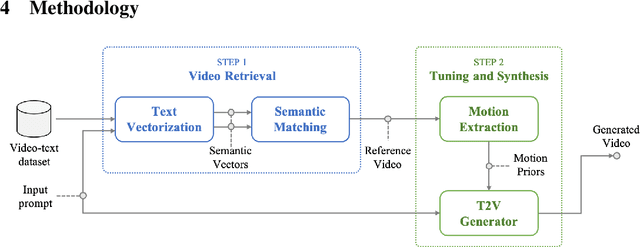

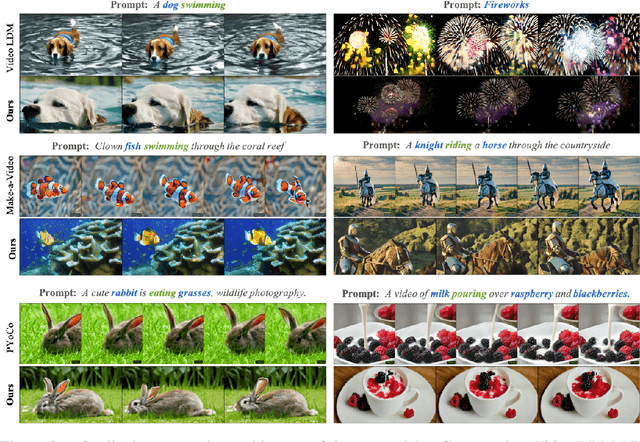
Abstract:Significant advancements in video diffusion models have brought substantial progress to the field of text-to-video (T2V) synthesis. However, existing T2V synthesis model struggle to accurately generate complex motion dynamics, leading to a reduction in video realism. One possible solution is to collect massive data and train the model on it, but this would be extremely expensive. To alleviate this problem, in this paper, we reformulate the typical T2V generation process as a search-based generation pipeline. Instead of scaling up the model training, we employ existing videos as the motion prior database. Specifically, we divide T2V generation process into two steps: (i) For a given prompt input, we search existing text-video datasets to find videos with text labels that closely match the prompt motions. We propose a tailored search algorithm that emphasizes object motion features. (ii) Retrieved videos are processed and distilled into motion priors to fine-tune a pre-trained base T2V model, followed by generating desired videos using input prompt. By utilizing the priors gleaned from the searched videos, we enhance the realism of the generated videos' motion. All operations can be finished on a single NVIDIA RTX 4090 GPU. We validate our method against state-of-the-art T2V models across diverse prompt inputs. The code will be public.
Pseudo Label Refinery for Unsupervised Domain Adaptation on Cross-dataset 3D Object Detection
Apr 30, 2024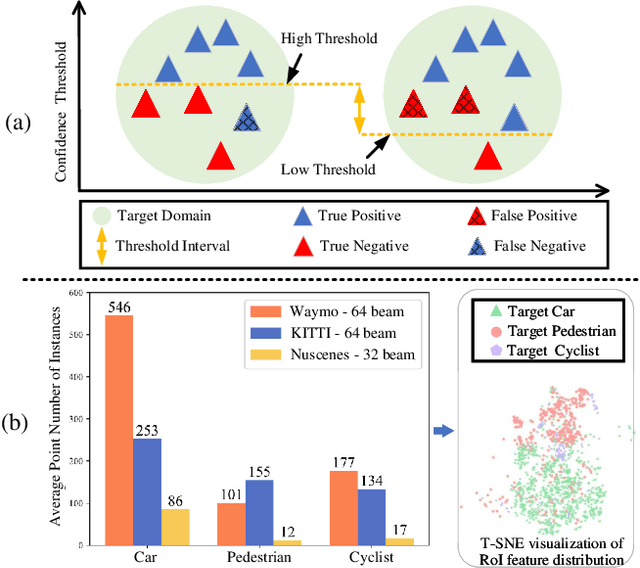
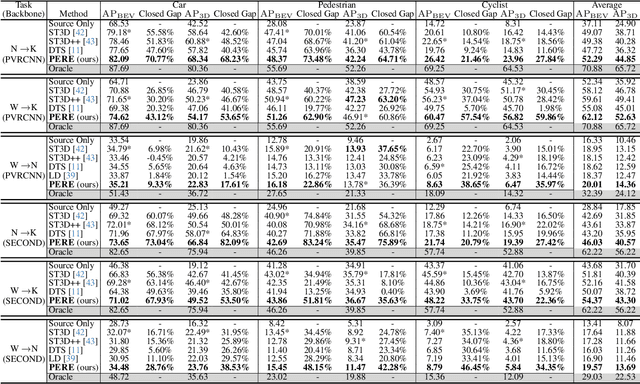
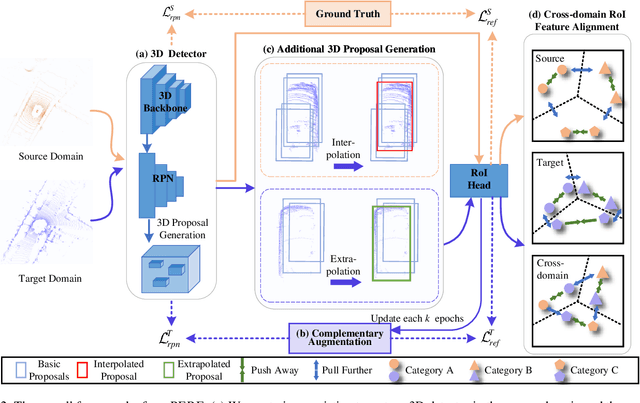

Abstract:Recent self-training techniques have shown notable improvements in unsupervised domain adaptation for 3D object detection (3D UDA). These techniques typically select pseudo labels, i.e., 3D boxes, to supervise models for the target domain. However, this selection process inevitably introduces unreliable 3D boxes, in which 3D points cannot be definitively assigned as foreground or background. Previous techniques mitigate this by reweighting these boxes as pseudo labels, but these boxes can still poison the training process. To resolve this problem, in this paper, we propose a novel pseudo label refinery framework. Specifically, in the selection process, to improve the reliability of pseudo boxes, we propose a complementary augmentation strategy. This strategy involves either removing all points within an unreliable box or replacing it with a high-confidence box. Moreover, the point numbers of instances in high-beam datasets are considerably higher than those in low-beam datasets, also degrading the quality of pseudo labels during the training process. We alleviate this issue by generating additional proposals and aligning RoI features across different domains. Experimental results demonstrate that our method effectively enhances the quality of pseudo labels and consistently surpasses the state-of-the-art methods on six autonomous driving benchmarks. Code will be available at https://github.com/Zhanwei-Z/PERE.
 Add to Chrome
Add to Chrome Add to Firefox
Add to Firefox Add to Edge
Add to Edge